King's Mantle
Latin: Thunbergia erecta
Family: Acanthaceae
English: King's mantle, Bush Clock Vine
Indonesian: (unknown)
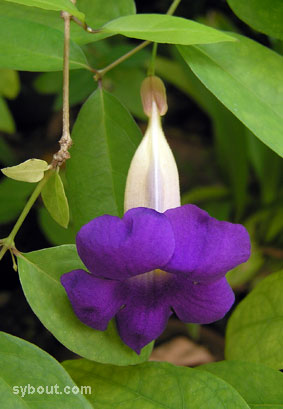
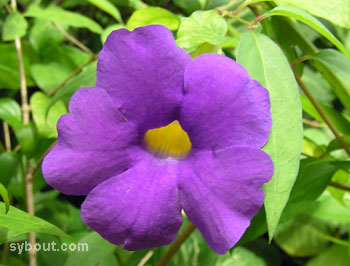
Sometimes I hear myself saying "Shit wat
mooi!" (Dutch for "how beautiful!") when I see the colours of the
flower shown in the pictures above here again.
As its botanical name says, Thunbergia erecta has "upright" branches and is not a climber
like many other well known Thunbergia species (e.g. Thunbergia grandiflora shown under "Vines & Creepers".
The branches of the King's Mantle are not very strong though, and bend down when growing longer. Pruning can
help to create a more sturdy bush. If you are afraid to disturb
flowering is might be better to provide some support. Without
support the plant will grow up to about one meter height. Leaf size
is about 4 - 7 cm but can reach 10 cm at vigorous young shoots.
In my garden I grow some plants in pots. They are placed in a spot
where they receive full sun only a part of the day and seem to feel
well there.
Orange Jasmine
Latin: Murraya paniculata (M. ovatifolioata)
Family: Rutaceae
English: Orange Jasmine, Mock Orange
Indonesian: Kemuning
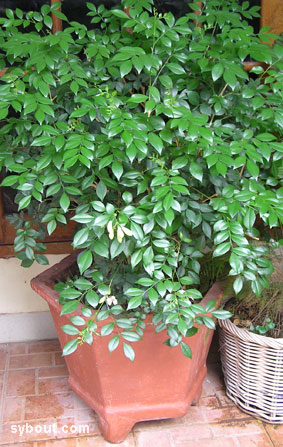
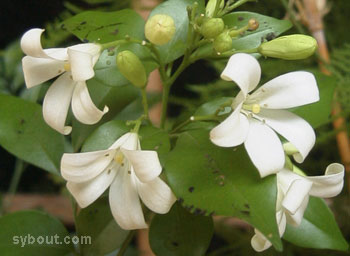
The Orange Jasmin is a
member of the orange family and a close relative of the Curry Leaf (Murraya koenegii). Its area of origin is China, Southeast Asia and the Malay Peninsula.
The species is attractive because of the shiny dark green leaves and the strongly
scented small white flowers. The flowers are followed by about 1 cm
long orange to red coloured fruits. Flowers appear all year round with a peak in the rainy
season. The leaves exist of 3-7 oddly pinnate leaflets.
The plants can grow as tall as four meters high if
planted in open soil. Orange Jasmin prefers full sun, but will do
well in a light place in the shade too. It grows well in most soil
types. The species stands pruning well, and therefore is often used
for hedges. Flowering will be reduced if trimmed often.
Propagation is from seeds and cuttings.
In my garden I grow a
Orange Jasmin in a pot. It has had the same size for years because
of regular pruning. Flowering is never abundant, but a few flowers
is enough to spread the pleasant fragrance.
Jungle Flame
Latin: Ixora javanica
Family: Rubiaceae
English: Jungle Flame, Javanese Ixora, Jungle Geranium
Indonesian: Soka
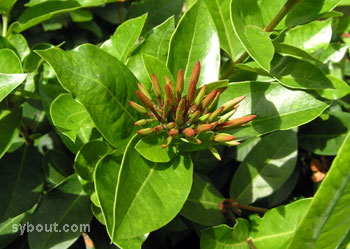
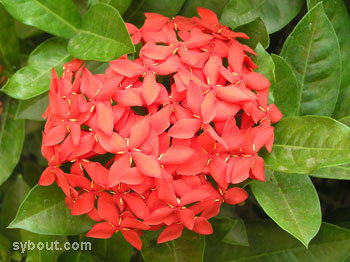
The Jungle Flame is an easy to grow
plant that can reach several meters height. In Indonesia it belongs
together with Hibiscus to the most popular flowering shrubs. It produces all year
round large clusters of small red flowers. The species is strong and
stands dry spells well, though its inflorescences will become
smaller if soil moisture falls low. Only a very small part of the
flowers will develop in a berry-like fruit.
The plants stand
pruning well, and will develop a dense crown if pruned regularly.
Propagation is easiest
done by layering. Sometimes new shoots appear from the mother
plant's root system. These can easily be separated and uprooted for
propagation.
Peacock Flower
Latin: Caesalpinia pulcherrima
Family: Rutacea
English: Peacock Flower, Dwarf Poinciana
Indonesian: Kembang Merak
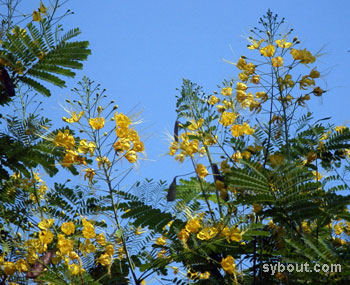
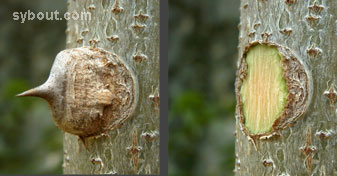
but are part of the bark of the tree. So, in botany they probably
are not called thorns, but prickles.
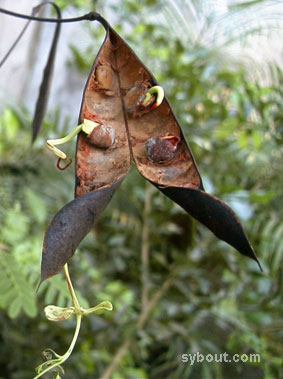
The Peacock Flower is a fast growing legume with beautiful compound
leaves. Its inflorescence are attractive as well and vary in color
from yellow, orange to reddish purple. The plants have bristle
branches with thorns. The shape of older shrubs unfortunately is
less attractive. Pruning does not help much to get a better shape as
the plant will develop many long straight new shoots.
Flowers turn into pods that snap open if the
seeds have ripened and the pods are dry. Seeds can be shot several
meter away. During extreme humid periods in the rainy season this
way of seed spreading dissemination is disturbed, because the seeds
germinate in the pods that do not dry well (see photo above here).
Propagation of the
Peacock Flower is done from seed.
Gardenia
Latin: Gardenia jasminoides
Family: Rubiaceae
Indonesian: Gardenia
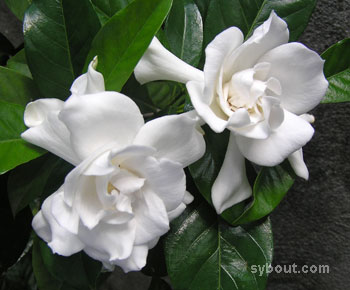
Gardenia jasminoides is
a native of South China. There this species had been cultivated for
at least thousand years already when Westerners learned to know the
plant. This medium sized small shrub is popular for its shiny leaves
and large pure white fragrant flowers. The flowers turn creamy white
after a few days, but keep their fragrance.
In the twenties of last
century Gardenia among others was used by men as a fragrant
decoration in a button-hole of the jacket.
Propagation is from woody cuttings or by air-layering (marcotting).
Difficulties that I experience: often flower buds drop before opening (eaten by insects?).
Desert Rose
Latin: Adenium obesum
Family: Apocynaceae
Indonesian: Kamboja Jepang, Adenium
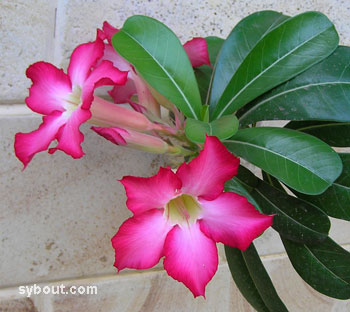
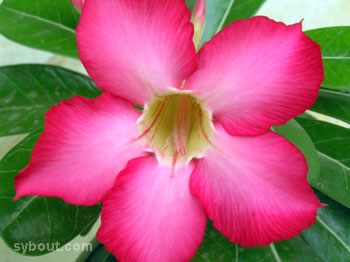
The Indonesian name could make you think that this plant if from Cambodia or Japan. Both are wrong.
The Desert Rose is native to eastern and southern tropical Africa, as well as the Arabian peninsula.
This succulent plant that is a member of the oleander family can reach a height of about one and a half meter. The stem is often swollen at the base and sometimes twisted. It has attractive dark green shiny leaves and bright coloured flowers. The flowers are trumped shaped and appear all year round.
Desert Rose needs sunny place in a well drained soil that is frequently dry. A soil that is wet for long periods can cause rotting of the stem. The species grows very well in pots. Clay pots are preferred above plastic pots.
Not all flowers develop seed pods. The surprisingly long pods open when mature and expose the seeds that lay in a cotton-like material.
Propagation is by means of seed or cuttings. Seeds germinate easily in a mixture of sand and soil. Cuttings can best be dried a few days before planting.
Like many succulents all parts of the Desert Rose are poisonous.
Angel's Trumpet
Latin: Datura candida
Family: Solanaceae
Indonesian: Bunga Trompet, Kecubung Gunung
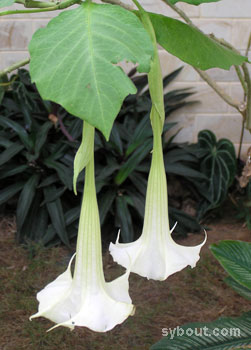
The Angel's Trumpet
is a shrub that can reach a hight of about four meters. Its area of
origin is thought to be The mountains of Peru and Chili. Its pure
white trumpet shaped hanging flowers are about 30 cm in length and
have typical upwards bound tips. The flowers spread is nice
fragrance during the evening and the night.
The shape of the shrub easily becomes less attractive in time, but with some pruning this can be improved.
Rhododendron x pulchrum
Latin: Rhododendron x pulchrum
Family: Ericaceae
English: (unknown)
Indonesian: Azalea Ungu
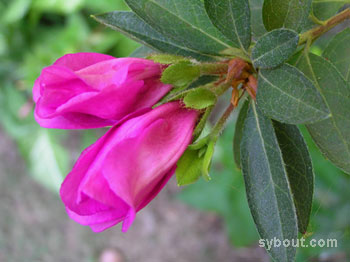
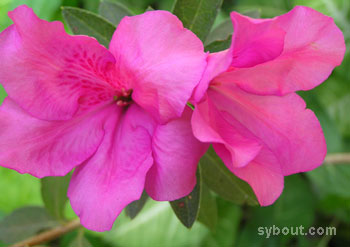
According to some sources
Rhododendron x pulcherima is a horticultural hybrid derived from R. ledifolium, of Hooker, impregnated by the pollen of the Old Red R. indicum. It
is a woody shrub that can grow up to about 1.5 meter high.
Its leaves are 3 - 4 cm long, somewhat grayish green and have a rough surface.
In the tropics the species seems to be more suitable for
mountain areas than areas at sea level. It flowers several times a
year. The flowers measure about 8 cm across and exist of five purple to rose coloured petals
with five small green hairy sepals. Usually there are two or three flowers
together with a rosette of leaves at the base. White and pink
flowering variety as
well exist.
The plant prefers a humid, humus-ridge and
lime-free soil.
The plant growing in
my garden gets full sun four a part of the day. During the dry
season it produces very few flowers. As soon rain starts the plant
starts blooming.
Cat's Wiskers
Latin: Orthosiphon stamineus
Family: Lamiaceae
English: Orange Jasmine, Mock Orange
Indonesian: Kumis Kucing
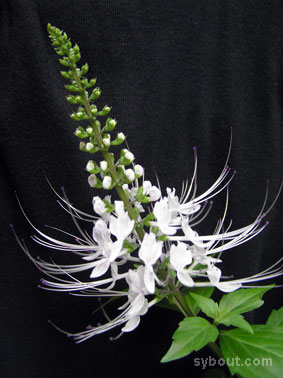
In Indonesia 'Kumis Kucing'
(Cat's Wiskers) is generally known as a medicinal plant used for
treating diabetes, kidney and urinary disorders.
It produces long
sprays of white or pale mauve flowers with extremely long stamens
that are the reason for its English and Indonesian name. Flowers
appear all year round. The
branches of Cat's Whiskers are quadrangular. Its leaves are smooth
lanceolate shaped with toothed margins.
The plants like full
sunlight or a partly shaded place with well drained soil.
The
shape of the shrubs can become messy as its branches tend to grow
very long and bend to the ground.
This can be prevented by pruning after
flowering.
Propagation is by means of cuttings.
Four O'Clock Plant
Latin: Mirabilis jalapa
Family: Mirabilis jalapa
English: Four O'Clock Plant, Marvels of Peru
Indonesian: Bunga Pukul Empat
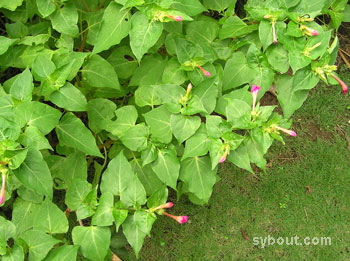
The English and Indonesian name of this species refer to the fact that its flowers open around four o'clock in the afternoon. These fragrant trumpet shaped flowers close again the next morning. Actually the flowers open as reaction on a drop of the temperature and not because of the time of the day. In my garden the flowers rarely open before 5 o'clock.
The origin of the Four O'Clock Plant lies in tropical America, some sources say Peru.
The plant usually does not grow much taller than half a meter. Its leaves are oval (heart shaped?) and shiny. The purple and white flowered variety are probably most common. Next to these there are varieties with red, pink, orange and yellow flowers.
The Four O'Clock Plant grows best in full sun or partial shade. The plant produces seeds that are oval black with a wrinkled surface when ripe. Propagation is from seeds.
In my garden I have a purple flowering variety of this species growing in a sunny spot. Regularly new plants appear from dropped seeds. The plants do not invade the shady parts of the garden.
Red Ginger
Latin: Alpinia purpurata
Family: Zingiberidea
English: Red Ginger, Ostrich Plume, Pink Cone Ginger
Indonesian: Jahe Hias, Jahe Merah Obor
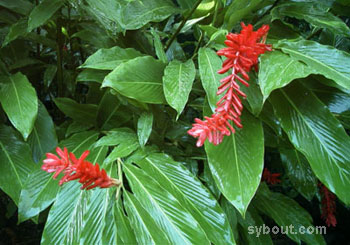
Alpinia is a member of the ginger family. This species grows in clusters of long stems with long leaves that can become up to 2 meters high. It has
long lasting bright red flowers (actually bracts with small white
flowers inside) of about 20 - 40 cm long.
Red ginger likes
partial shade or full sun and a moist well-drained soil.
Propagation is by means of dividing the roots, clusters or by planting the
young plants that are developed at the base of old flowers.
Pigeonberry
Latin: Rivina humilis
Family: Phytolaccaceae
English: Pigeonberry, Bloodberry, Rouge Plant, Baby Pepper
Indonesian: Getih-getihan, Anggur-angguran
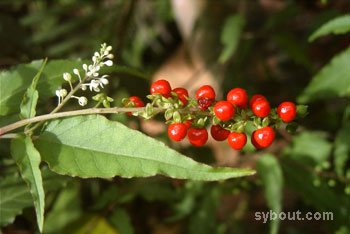
Pigeonberry is a
small perennial shrub with a height of around 1 meter. The plants
are herbaceous with sometimes a wooden base. The leaves are ovate to
lanceolate with a length of about 10 cm.
The species produces
attractive small round bright red berries with four green petals at
the base. The flowers are very small
and white or pink coloured. Flowers and berries are often present at
the same time.
Its origin is said to be the West Indies. The species is now common
as well in the in Hawaii and southern area of USA.
Pigeonberry grows best in a light place protected from direct sunlight
with humid soil.
Propagation is by cuttings or seeds.
After bringing a
potted plant home, soon seedlings showed up all over the garden,
especially in shady places. All the plants have pure white flowers.